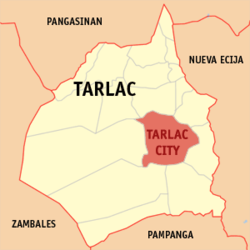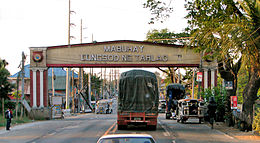Tarlac City
|
Tarlac City Ciudad Ning Tarlak Lungsod Ng Tarlac |
||
| Location of Tarlac City in the Tarlac Province | ||
|---|---|---|

|
||
| Basic data | ||
| Region : | Central Luzon | |
| Province : | Tarlac | |
| Barangays : | 76 | |
| PSGC : | 036916000 | |
| Income class : | 1st income bracket | |
| Households : | 57,710 May 1, 2000 census
|
|
| Population : | 342,493 August 1, 2015 census
|
|
| Population density : | 1247 inhabitants per km² | |
| Area : | 274.66 km² | |
| Coordinates : | 15 ° 28 ′ N , 120 ° 35 ′ E | |
| Postal code : | 2300 | |
| Mayor : | Gelacio "Ace" R. Manalang | |
| Website: | www.tarlaccity.gov.ph | |
| Geographical location in the Philippines | ||
|
|
||
Tarlac City is the capital of the Tarlac Province and is located on the island of Luzon in the Philippines . It has 342,493 inhabitants (August 1, 2015 census). The city is considered to be one of the most highly urbanized cities in the Philippines.
geography
Tarlac City is located in the northern center of the great central plain of the island of Luzon. Its neighboring communities are Gerona in the north, Santa Ignacia , San Jose in the west, Capas , Conception in the south, La Paz , Victoria in the east.
The terrain is extremely flat, only 9% of the total city area of 274.66 km² has steep gradients of over 3%. The Tarlac River flows through the urban area . The city is about 125 km northwest of the Philippine capital Manila .
languages
The native language of the residents is 44% Ilokano and 43.6% Kapampangan . The others speak Tagalog (12.4%), Pangasinan (10.6%) and other regionally occurring dialects as their mother tongue .
religion
The vast majority of the population (86.77%) are followers of the Christian Roman Catholic faith . Another 7.77% of the population are supporters of the Iglesia ni Cristo church, which is only widespread in the Philippines . 5.46% of the population are followers of other Christian sects or other religions .
history
The first settlement in the area of the city was founded by Augustinian monks in 1686 and became an independent community as early as 1727. In 1788 the city of Tarlac was founded by Don Carlos Miguel and Don Narciso Castañeda and in 1973 it became the capital of the newly founded province of the same name.
During the Philippine-American War , Tarlac was the capital of the first Philippine republic under Gen. Emilio Aguinaldo after the fall of Malolos City (Bulacan).
The city of Tarlac was granted on March 13, 1998, with the Republic Act going into effect. 8593, bestowed the title of a major city.
Barangays
The city of Tarlac is divided into 76 barangays .
|
|
|
|


